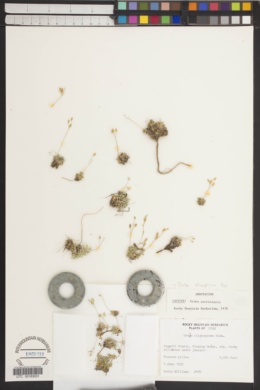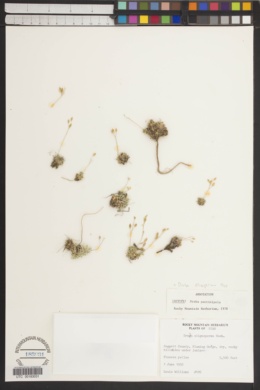Draba pectinipila
|
|
|
|
Family: Brassicaceae
Sagebrush Whitlow-Grass
|
Perennials; (cespitose, sometimes forming mats); caudex branched (with persistent leaf bases, branches creeping, terminating in scapes or sterile rosettes); scapose. Stems unbranched, (0.3-)0.4-1.6(-1.9) dm, pubescent, trichomes sessile, pectinate, 0.1-0.4 mm, (parallel to long axis of stem, sometimes with irregularly 2-4-rayed ones, 0.2-0.6 mm). Basal leaves rosulate; subsessile; blade narrowly oblanceolate to linear, (0.4-)0.6-1.3(-2) cm × 0.9-2.2 mm, margins entire (not ciliate), surfaces pubescent with subsessile or sessile, pectinate trichomes, 0.2-0.5 mm. Cauline leaves 0. Racemes 5-22-flowered, ebracteate, considerably elongated in fruit; rachis not flexuous, pubescent as stem. Fruiting pedicels divaricate-ascending, straight, (5-)7-14 mm, sparsely pubescent, trichomes pectinate. Flowers: sepals broadly ovate, 2-3.2 mm, pubescent, (trichomes pectinate); petals yellow, obovate to spatulate, 4-6.5 × 1.5-2.5 mm; anthers ovate 0.4-0.5 mm. Fruits ovoid, plane, slightly inflated basally, 4-6(-7) × 2-3 mm; valves pubescent, trichomes usually sessile, pectinate, 0.2-0.5 mm, rarely with simple ones; ovules 4-8 per ovary; style 0.5-1.5 mm. Seeds oblong, 1.1-1.5 × 0.6-0.8 mm. 2n = 22. Flowering Apr-Jun. Rocky slopes in sagebrush scrub and pinyon-juniper woodlands; 1700-2400 m; Colo., Mont., Utah, Wyo. Draba pectinipila was treated as a synonym of D. oligosperma by G. A. Mulligan (1972), R. C. Rollins (1993), and N. H. Holmgren (2005b). The latter recognized D. juniperina as a distinct species but overlooked the fact that it is indistinguishable from the type collections of the earlier-published D. pectinipila. The species (including D. juniperina) differs significantly from D. oligosperma in both chromosome number and morphology. Draba pectinipila is easily distinguished by having fruit valves pubescent with pectinate trichomes, fruiting pedicels (5-)7-14 mm, petals 4-6.5 mm, ovules 4-8 per ovary, and styles 0.5-1.5 mm. By contrast, D. oligosperma has fruit valves glabrous or pubescent with simple or 2-rayed trichomes, fruiting pedicels (2-)3-10(-13) mm, petals 2.5-4 mm, ovules 6-12 per ovary, and styles 0.1-0.8(-1.1) mm. Draba pectinipila was previously known only from the type locality in northwestern Wyoming (Park County). Its range is now expanded to include that of D. juniperina in northwestern Colorado (Moffat County), northeastern Utah (Daggett and Uintah counties), and southwestern Wyoming (Sweetwater County). The record from Uintah County is based on Goodrich 22275 (NY).
|














